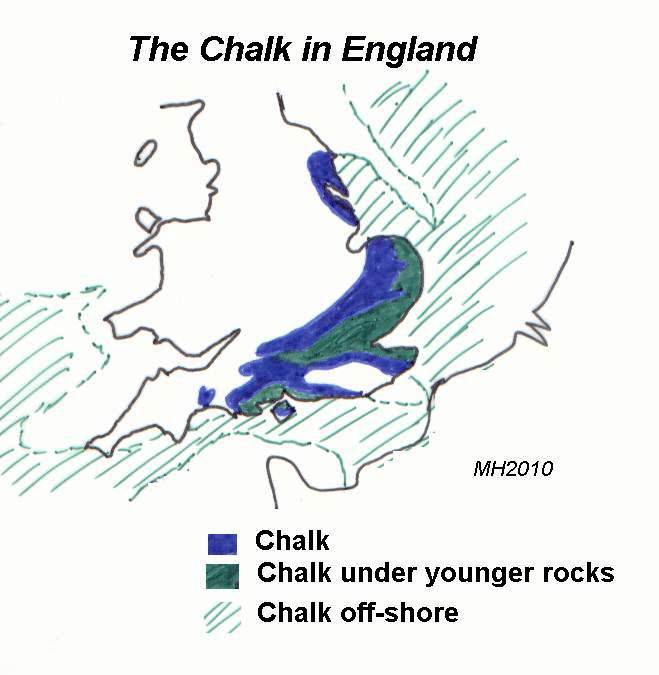

The Yorkshire Chalk
A brief introduction:

For most people, many geologists included, the chalk is a rather uninteresting rock. There are nearly 400 metres of Chalk exposed in Yorkshire and it is all white!! The middle bit has some flint in it and throughout fossils are difficult to find. But for the dedicated few, close study over a period of time will start to reveal the secrets of the Chalk. Study by geologists over the last 20 years has now produced stratigraphic logs of the exposures and it is possible to link up most of the sequence. The major marker horizons have been given names to make understanding the stratigraphy easier by Wood & Smith (1978) , Wood (1992 in Fletcher, Gaunt & Wood), and Whitham (1991, 1992 in Rawson & Wright and 1993) and some new names are included in these web pages.
The Chalk in Yorkshire and North Lincolnshire is much harder than the Chalk of southern Britain. This is due to cementation, compression and the filling of pore spaces. This is perhaps caused by deeper burial. At coastal exposures, stylolites are fairly common and are caused by pressure solution. In the northern part of the Wolds the Chalk is hard enough to be used as a building stone.
The Chalk is a very pure limestone, made up of calcite, mostly as the plates of small algae, called coccoliths, but also as fossil formainifera and needle-like crystals from broken shells of Inoceraumus bivalves. Fossil ammonites and gastropods are very rare because their aragonite shells have been disolved (see pp 13-15 of Gill 1996).
A common feature of all the sequence is the marl bands. These are calcareous clays, containing between 50 % and 80 % non-calcareous material. Some of these can be shown to be the remains of volcanic ash falls. Others are due to periods of slow deposition of calcium carbonate or greater input of clay enriching the relative percentage of the clay from its usual 1% or 2% . Others are associated with stylolites indicating formation due to pressure solution of the carbonate material. Many of these marl bands are traceable for large distances.
One notable marl is the famous Black Band Member; which includes a dark, carbon-rich clay which contains a very reduced diversity in its microfauna and well preserved fish scales. This is thought to be a representation of the late Cenomanian anoxic event (O.A.E.2), a world wide extinction horizon. Flints occur in the Turonian and Coniacian chalks, starting with finger flints (formed in thin burrows), going through nodular and lenticular flints to thick tabular flints at the 'Flint Maximum'. These flints can also be traced over large areas, but are not quite as reliable as the marl bands for stratigraphy. After the 'Flint Maximum' they get smaller in size and the highest ones become irregular and are probably diachronous. No one is yet certain how the flints formed, but the most likely explanation is the precipitation of silica due to reducing conditions a metre or two beneath the sediment-water interface. But this does not explain why they only occur in the middle of the Yorkshire Chalk, perhaps this is because their formation is related to water depth?
The Yorkshire flints are grey in colour and are not good for knapping into flint implements. Black, red and brown flints can be found as erratics from the boulder clay. The black flints are probably of late Campanian or early Maastrichtian age and come from Chalk that was exposed on the bed of the North Sea during the Ice Age. The red flints may be of Danian (earliest Tertiary) age or perhaps Turonian age. The brown ones have that colour due to weathering - these are more common in southern Britain.
The Chalk is not like other rocks - its very monotonous and persistant nature is what impresses me. In Yorkshire it is about 400 metres thick and that was deposited from the Cenomanian stage up into the Early Campanian (though younger Chalk may have been deposited and eroded). In other areas the Chalk continues up to the end of the Maastrichtian stage - a total of over 30 million years. I have also seen Chalk in Lincolnshire, Norfolk, Kent, Sussex, Hampshire, Wiltshire and Dorset. It can also be found in Northern Ireland, Denmark, France, Germany, Poland, Bulgaria, Turkey, Egypt, Texas, Arkansas, Mississippi, Alabama and Australia (Ager 1993, p1-3). Even if you bear in mind the effects of continental drift - chalk deposition took place over a huge area.
Copyright - Hull Geological Society 2006
Registered Educational Charity No. 229147